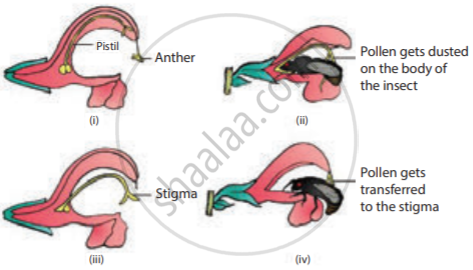Advertisements
Advertisements
प्रश्न
Explain the pollination mechanism in Salvia.
उत्तर
Pollination in Salvia (Lever mechanism): The flower of Salvia is adapted for Bee pollination. The flower is protandrous and the corolla is bilabiate with 2 stamens. A lever mechanism helps in pollination. Each anther has an upper fertile lobe and lowers sterile lobe which is separated by a long connective which helps the anthers to swing freely. When a bee visits a flower, it sits on the lower lip which acts as a platform. It enters the flower to suck the nectar by pushing its head into the corolla. During the entry of the bee into the flower, the body strikes against the sterile end of the connective. This makes the fertile part of the stamen descend and strike at the back of the bee. The pollen gets deposited on the back of the bee. When it visits another flower, the pollen gets rubbed against the stigma and completes the act of pollination in Salvia Some of the other interesting pollination mechanisms found in plants are a) Trap mechanism (Aristolochia); Pitfall mechanism (Arum); Clip or translator mechanism (Asclepiadaceae) and Piston mechanism (Papilionaceae).

Pollination in Salvia - Lever mechanism
APPEARS IN
संबंधित प्रश्न
First cell of male gametophyte in angiosperm is
List any two strategy adopted by bisexual flowers to prevent self-pollination.
Give short notes on types of ovules.
Discuss the steps involved in Microsporogenesis.
With a suitable diagram explain the structure of an ovule.
Identify the function/s of integuments.
Ovule is attached to the ______ by a small stalk called funiculus.
Match the Column I (Type of pollination) and Column II (Characteristics). Select the correct option.
| Column I | Column II | ||
| a. | Ornithophily | 1. | Nocturnal flower |
| b. | Entomoohily | 2. | Light pollens |
| c. | Chiropterophily | 3. | Funnel-shaped corolla |
| d. | Anemophily | 4. | Pleasant fragrance and nectar |
From the following which is NOT true about self-pollination?
During the formation of leaves and elongation of stem, some cells ‘left behind’ from the shoot apical meristem, constitute the:
